序章
Today, let’s talk about the “new favourite” in the theatre – LED表示. Have you ever wondered why theatre performances are becoming more and more immersive?
In fact, LED displays have made great contributions! It not only presents super cool pictures but also makes the audience feel like they are in another world. Find the specific reasons in the article.
目次
1. Why is immersive theatre so popular?
The charm of immersive theatre is that it allows the audience to “really enter” the play. In traditional theatres, the audience can only watch the stage from a distance, but immersive theatre directly pulls the audience into the story.
For example, in “Crazy Barber Shop”, the audience can not only watch the play but also help solve the case and feel like they are the characters in the play.
Moreover, the scene layout of the immersive theatre is very attentive, and the props, lighting, and sound effects are very realistic, making people feel like they are in another world.
Like “Sleepless Night”, the abandoned building was transformed into a retro hotel, and every detail makes people immersed in it.
This unique experience allows the audience to no longer just watch the play, but to truly “immerse themselves in the play”, which is difficult for traditional theaters to achieve.
Immersive theatres are not only fun but also particularly suitable for socializing.
Audiences can interact with others, such as discussing the plot in groups and completing tasks. This kind of communication brings everyone closer at once.
Moreover, this experience is particularly suitable for sharing. After watching it, you can chat with friends enthusiastically and even show it off on social platforms.
This kind of interaction and sharing fun makes immersive theatre a new way of socializing, especially for people who like fresh experiences.
Immersive theaters are not only fun, but also have cultural connotations. Many plays are integrated with rich cultural elements.
For example, “Tian Niang” is set in Maotai Town and tells the story of Jiangxiang culture. The audience can learn about traditional culture while watching the play.
Moreover, immersive theatres are increasingly integrated with tourism and business.
While enjoying the performance, the audience can visit attractions, eat, and shop. This “one-stop” experience is particularly popular.
The popularity of immersive theatres is also related to modern consumption trends. People now pay more and more attention to experience and feelings, and immersive theaters just meet this demand.
Its repertoire is rich in variety, including suspense, love, history, science fiction and other themes, and the audience can choose according to their interests.
The consumption model is also very flexible. The audience can choose different experience projects according to time and budget. This diversity and flexibility are particularly in line with modern people’s consumption habits.
2. Various ways for LED display screens to create immersive stage effects in theatres
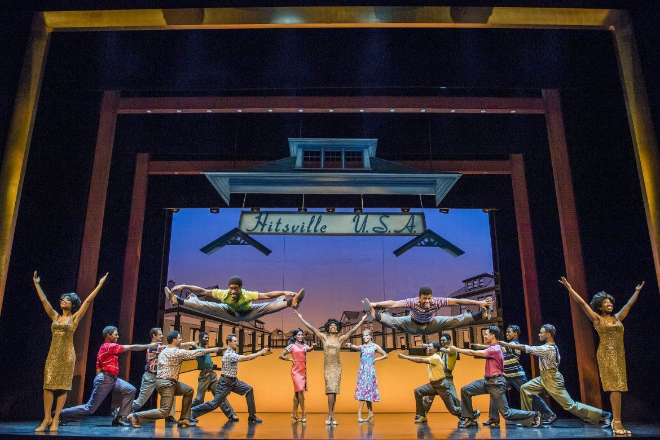
1). Presentation of background images
1.1). Create realistic virtual scenes
The high-definition LED display screen is like a “magic canvas” on the stage, which can “move” all kinds of exquisite background images directly to the stage.
For example, scenes such as forests, oceans, and cities can be perfectly presented on the screen.
Moreover, these images can be switched at any time according to the development of the plot.
For example, when performing an ancient court drama, the screen can suddenly become a magnificent palace or an exquisite garden, and the audience can instantly feel the strong ancient atmosphere as if they have travelled back to that era.
This realistic virtual scene makes the audience no longer feel that the stage is fake but really enters the world of the story.
1.2). Enhance the sense of depth of the scene
The power of the LED display is that it can create an “immersive” sense of depth.
For example, when showing the valley scene, the picture on the screen will adjust the layers and light and shadow to let the audience feel the depth and layering of the valley.
It feels like the valley is right in front of them, and the audience even feels that they can walk into the picture. This sense of depth makes the stage background no longer a simple curtain but a three-dimensional, real space.
2). Fusion of lighting and picture
2.1). Synchronous change
の ステージ lighting and the picture of the LED display can change together “hand in hand”. For example, if the picture is of a starry sky at night, the lights will dim and turn blue to create a quiet atmosphere in the night sky.
When the picture switches to sunrise, the lights will gradually brighten and turn into a warm orange tone, which perfectly matches the sunrise scene in the picture.
This synchronous change of lighting and picture makes the audience’s visual experience more natural and real as if they are really in that scene.
2.2). Interactive effects
Lighting and LED displays can also create more interesting interactive effects. For example, in a dance performance, the actor’s movements can trigger changes in lighting and images.
When the actor dances, the lighting and images will also move with him. The lights will flash with the dancer’s rhythm, and the images will change according to the dancer’s movements.
This interaction makes the audience feel that there is a “tacit understanding” between the actor and the stage environment, and the audience will also immerse themselves in it and feel the unique atmosphere.
3). Display of dynamic images
3.1). Simulating natural phenomena
LED displays are particularly good at simulating various natural phenomena, such as water flow, flames, wind and snow, etc.
When performing an adventure play, when the plot develops to the scene where the protagonist crosses the waterfall, the screen will show a dynamic picture of water cascading down.
With the water spray device on the stage, the audience can seem to feel the water vapour and roar of the waterfall.
This dynamic picture makes the scene more realistic, and the audience feels like they are really there, which enhances the sense of immersion.
3.2). Create a sense of rhythm and movement
LED displays can also create a vibrant atmosphere for stage performances through fast-moving images and a strong sense of rhythm.
For example, in modern dance performances, the screen can display abstract geometric shapes and fast movement of lines, which will echo the dancers’ movements.
When the audience sees the dancers dancing in these dynamic images, the whole stage seems to be injected with vitality, full of rhythm and movement, which makes people dazzled and completely immersed in it.
4). Construction of three-dimensional space
4.1). Multi-screen linkage
By linking multiple LED screens, a complete three-dimensional space can be constructed. These screens can display images from different angles, and the audience can feel the complete three-dimensional effect no matter where they watch from.
For example, in large-scale musical performances, LED screens are installed around and above the stage, and they cooperate with each other to show a virtual three-dimensional world.
The audience is like being surrounded by this world, and the sense of immersion is so strong that they seem to be part of the stage.
5). Interaction with the actors’ performances
5.1). Real-time tracking and feedback
Now there are some powerful technologies, such as sensors and image recognition, that allow LED screens to track the position and movement of actors in real time and adjust the picture according to the actors’ performances.
For example, when an actor walks to a certain area of the stage, the screen will automatically adjust the viewing angle and content of the picture to make the picture more in line with the actor’s performance.
When the audience sees this “seamless connection” effect, they will feel that there is a close connection between the actor and the stage environment, and the sense of immersion will be greatly enhanced.
5.2). Interaction between virtual characters and actors
The LED display can also display virtual characters, allowing virtual characters to perform with actors. This combination of virtual and real is particularly interesting.
For example, in children’s plays, actors can talk and interact with virtual cartoon characters on the screen.
Children will feel that these virtual characters really appear on the stage, their imagination and interest are fully stimulated, and they can easily immerse themselves in the plot.
This interaction not only makes the stage more fantastic but also enriches the audience’s experience.
3. LED display screens suitable for installation in immersive theatres
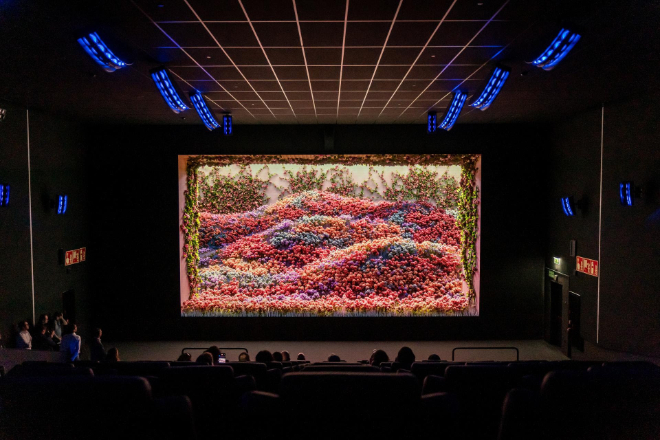
1). Small pitch LED display screens
Small pitch LED display screens are ideal for immersive theaters.
Their dot pitch is very small (such as P2.5, P3), which means that the pixels on the screen are very dense and can present ultra-high-definition pictures, just like arranging countless small light bulbs closely together, each of which can accurately emit light and color.
This type of screen is particularly suitable for close-up viewing. For example, in a theatre, the audience is very close to the stage.
The small-pitch LED screen can make the picture look extremely delicate. Whether it is the subtle expressions of the characters or the exquisite details of the scene, they can be clearly presented.
For example, in a costume drama, the palace on the screen is clearly visible with carved beams and painted buildings, and every brick and tile is clearly visible, and the audience seems to be in an ancient palace.
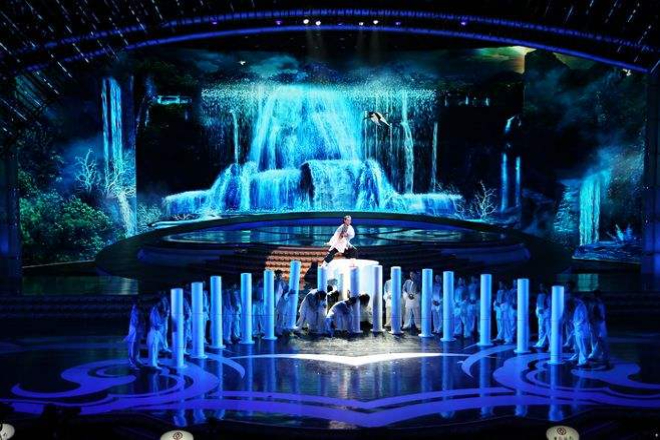
2). Curved LED display
The curved LED display is like a magical screen that can be bent and can be customized according to the shape and space requirements of the theater. Imagine that the walls of the theater are curved, and the curved LED screen can fit perfectly.
From the audience’s perspective, the picture is coherent and smooth, without any sense of separation.
This screen can create an enveloping visual experience, making the audience feel surrounded by the picture, and the immersion is super strong.
For example, in a science fiction performance, the screen presents the vast universe, and the audience feels like they are floating in the interstellar, surrounded by bright stars.
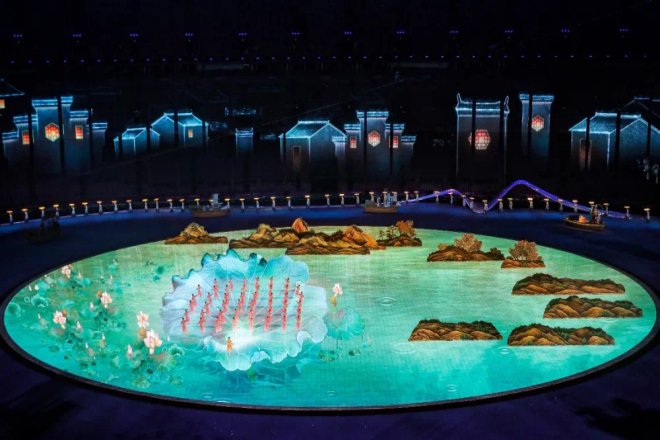
3). LEDフロアスクリーン
The LED floor screen is like a “smart carpet” on the stage. It can not only display the picture, but also sense the audience’s movements.
The audience can walk and jump on the floor tile screen, and the screen will change the picture according to the sensed pressure.
For example, in a children’s play, when the children walk onto the stage, the footprints of small animals will appear on the floor tile screen, moving with the children’s footsteps, or petals will appear and spread out as the children dance.
This interactivity makes the performance more interesting and vivid. The audience is no longer a passive observer but can interact directly with the stage.
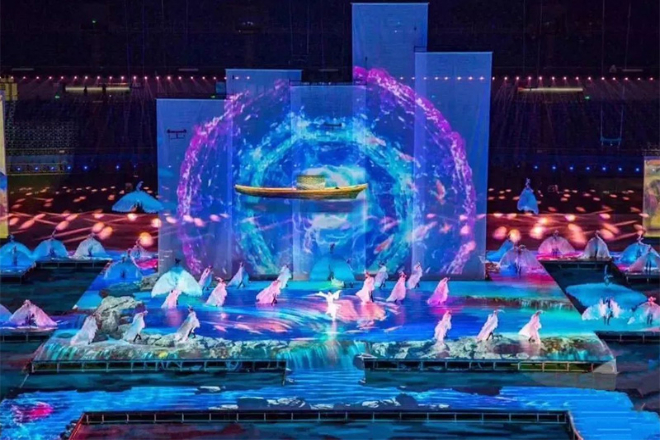
4). 透明LEDディスプレイ
The transparent LED display is like a piece of luminous glass, which allows light to pass through while displaying the picture.
This screen is particularly suitable for scenes that need to create special visual effects. For example, in a modern dance performance, the background of the stage is a huge glass wall.
The transparent LED screen is installed on the glass, which can show a dreamy light and shadow effect without blocking the audience’s view of the entire stage.
It allows the audience to see the performance on the stage while feeling the atmosphere brought by the background picture, such as the virtual city night view outside the glass wall, making the entire stage seem to be suspended in a bustling city.
5). LED dome screen
The LED dome screen is like putting a huge “luminous hat” on the theatre, which can create a 360-degree panoramic visual effect.
No matter where the audience sits, they can see the picture on the dome when they look up. This all-round visual impact makes people feel as if they are in another world.
For example, in an astronomical science performance, the dome screen presents a brilliant starry sky, and the audience is like lying in the universe, surrounded by twinkling stars and flowing nebulae. This sense of immersion is unmatched by other screens.
4. Challenges and coping strategies for the application of LED display screens in theatres
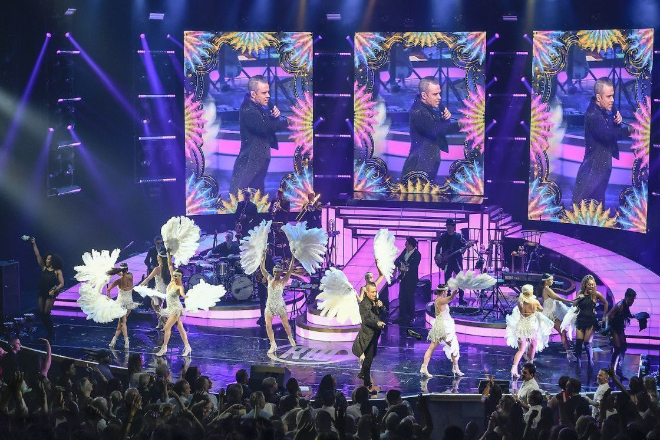
1). 技術的な課題
1.1). Display 解決 and image quality requirements
Nowadays, the audience’s eyes are becoming more and more “picky”, and the requirements for stage visual effects are getting higher and higher.
The theatre stage area is large, and the audience is far away from the screen, which requires the resolution of the LED display screen to be high enough so that the picture can be clear and the details can be seen clearly.
For example, if the audience sits in the back row if the screen resolution is not enough, the picture will be as blurry as a “mosaic”, and it will be impossible to see it at all.
Moreover, colour reproduction and contrast are also very important. If the colour reproduction is not good, the picture will “deviate”.
If the contrast is not enough, the picture will look “grey” and have no sense of hierarchy. To solve these problems, you have to use high-quality LED display screens, such as small-pitch LED screens.
This screen has a small dot pitch, high resolution, and the picture looks particularly delicate.
At the same time, you have to optimize the color calibration and contrast adjustment technology of the screen to make the picture colorful and layered, so that the audience can see the picture clearly and realistically, just like watching a movie.
1.2). Synchronous control and data transmission
In the theatre, the LED display screen must “cooperate tacitly” with other equipment, such as stage lighting, sound, etc. This requires efficient synchronous control technology and a stable data transmission system.
If there is a problem with the synchronous control, the picture, lighting, and music will be “messy”, for example, the picture has switched to the next scene, but the lighting has not caught up, and the audience will feel awkward.
Therefore, it is necessary to develop advanced synchronous control technology, such as using a professional control system to synchronize the signals of the LED display screen and other devices, just like a conductor conducting an orchestra, so that each device can make the right action at the right time.
At the same time, the data transmission scheme must be optimized to ensure stable and fast signal transmission, avoid screen freezes or delays, and let the audience enjoy a smooth visual feast.
2). Challenges in artistic creation
2.1). Content creation and design
The content of the LED display screen must be “perfectly matched” with the plot, which puts high demands on content creation and design.
The creators must have rich artistic imagination and creativity and design unique and attractive pictures according to different plots and stage styles.
For example, in a fantasy drama, the picture must be able to show a fantasy worldview; in a historical drama, the picture must be able to restore the historical scene.
At the same time, factors such as the dynamic effect, colour matching and composition of the picture must also be considered.
For example, the dynamic effect must echo the actor’s movements and the development of the plot. When the actor moves, the picture also moves, which is interesting.
The color matching must be consistent with the overall tone of the stage and cannot be “abrupt”; the composition must be reasonable and highlight the key points.
Only in this way can the picture better serve the stage performance, create an immersive stage effect, and let the audience completely immerse themselves in the plot as if they were the characters in the play.
2.2) Integration with traditional stage art
Although LED display is a new “high-tech”, it has to “peacefully coexist” with traditional stage art forms, such as scenery, props, and costumes.
This requires creators to not only give full play to the advantages of LED display, but also not ignore the role of traditional stage art elements when designing stage plans.
For example, in a performance, an LED display can display a virtual background, but physical props on the stage are also necessary.
They can enhance the realism of the picture; the actor’s costume must match the style of the screen picture so that the entire stage can look like an organic whole.
The creators must cleverly combine the two, so that the LED display and traditional stage art elements complement each other and complement each other, and jointly create a complete stage art effect, bringing the audience a full range of artistic enjoyment, so that the audience can not only watch the excitement, but also understand the doorway.
5。結論
That’s all for today’s sharing! Do you think the LED display in the theatre is particularly magical?
Next time you go to the theater, don’t just stare at the actors, pay more attention to those screens, maybe you can find more hidden excitement!
最後に、LEDディスプレイについてもっと知りたい方は、 ご連絡ください。
